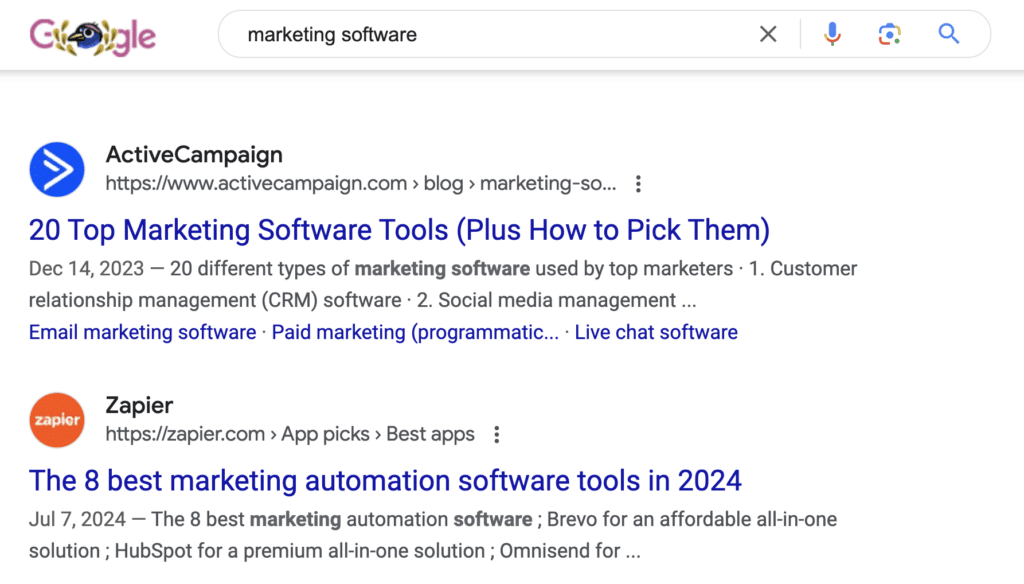When making a sales pitch, you want to sound eager but not desperate, but you also don’t want to sound too indifferent. Keyword placement for SEO in content requires a similar careful balance between too many, too few, or not being placed carefully enough to show a connection to a topic.
It’s a strategic dance with Google’s search algorithm. You want to be obvious enough with your keyword placement to improve your Google indexing but not too eager for Google to assume you are spam.
Here are ten tips for where to put keywords that yield the best results in Google.
Why Does Keyword Placement Matter?
In Google Search’s infancy, keyword placement was very straightforward. When a content creator used a word or phrase repeatedly in content, Google would naturally assume that was the topic’s theme and pull that content in relevant searches.
Imagine you sell shoes. You might repeatedly use phrases like “shoes for sale” or “cheap shoes” to attract your audience. The more often you use it, the higher your chances of Google ranking you.
Here was the issue. Spammers caught on to the algorithm and began keyword stuffing or placing keywords in every nook and cranny, hoping to increase their search engine ranking for that topic.
The problem was most of that content wasn’t that helpful or well-written. It would also sometimes be on a completely different topic.
That’s why Google shifted from keywords being the king of SEO to quality content being at the forefront. SEO content cannot rank without being well-written and demonstrating authority and personal experience.
However, keywords still play a valuable role because Google still needs to know what your content is about. The phrases you use in your content help the algorithm know (because it’s a computer, not a human that can use deductive reasoning). Since you are dealing with an algorithm, you need to be clear about your content’s theme by choosing keywords or search phrases your audience uses in Google search throughout your content in strategic spots that will stand out.
How Many Keywords Can You Use?
Can an article only rank for one keyword?
We often see our content ranking in several different searches. Google won’t only pull your content for the keyword you select. It can list your content for related searches, too.
However, trying to rank for too many keywords is like mastering several sports simultaneously. You may be able to rank in more searches, but you won’t master one. You would see much better results by having a laser focus and putting all your effort into ranking for a single phrase and related keywords in each blog post.
The related keywords appear one or two times each throughout the content, while the focus keyword has the spots of honor. By using synonymous and related keywords, you not only decrease your chances of Google seeing you as keyword stuffing but also read more naturally to readers because you aren’t repeating the exact phrase.
10 Places to Place Your Keywords
Learn where to put SEO keywords to see the best results and tips for sprinkling those secondary keywords around the focus keyword.
1. Blog Title
Your blog title is the H1 that appears at the top of your blog post. This is one of the most important spots for search engine keyword placement as it quite literally tells readers and Google what your content is about.
Try to include it naturally in the title, correcting grammar errors and using stop words when necessary. Stop words are words like a, and, your, and the that doesn’t change your keyword’s meaning – only make it more natural.
For instance, if your keyword is “best marketing tools,” your blog title might be “7 Best Marketing Tools Transforming Businesses in 2024.”
2. Introduction Paragraph
Your blog’s first section before the first sub-heading is your introduction. This section should be 200 words or less. It’s only a sneak peek at your content and doesn’t need to hold any essential information. However, it does need to contain your focus keyword.
Some marketers take this a step further and aim to have their focus keyword in the first paragraph. No significant data shows a difference between the first or last paragraph in the intro. You have this area covered as long as you hit on that keyword at some point while introducing the topic.
3. One or More Sub-Headers
While the title is the most important header for your keyword, you will want to include it in at least one sub-header. These are your H2s, H3s, H4s, etc.
What you want to avoid is adding your focus keyword in every single header.
Instead, switch up your focus keyword with synonymous keywords.
If your focus keyword is “financial services for doctors,” you might also use the phrases “medical financial services” and “healthcare financial services” in your H2s and H3s to avoid keyword stuffing and just sounding annoyingly repetitive.
4. Throughout the Body
The number of times a keyword appears in the text has no official rule, and the number of opinions on keyword distribution is as many as the number of SEO strategists.
However, one generally accepted concept is the 1% rule, or using keywords no more than once every 100 words, no matter how long your blog post is. Notice, I said KEYWORDS, not FOCUS KEYWORD. That’s because you want your focus keyword distribution to be much less dense. That ratio is for all your keywords.
Would you enjoy reading a sentence that sounded like this:
“When choosing the best smartphone repair near you, you want your smartphone repair service to match your smartphone repair cost.”
That’s not a sentence. That’s a string of keywords patched together.
Disperse all keywords once every 100 words unless they naturally fit closer together. Your focus keyword should only appear once every 400-500 words. You can even get away with it appearing less often if it’s very distinct and doesn’t fit naturally throughout. Instead, opt to use synonyms.
5. Meta Title
Your meta title is the blog post title that appears in search engine results pages. Usually, it will be the same as your blog title, especially when your writers create blog titles with the meta title in mind. However, there are times when you may need to change it up.
Your title should not be too long because Google’s search results pages (SERPs) have limited space. Ideally, it should fall between 50 and 60 characters with spaces, which comes out to 10-11 words.
Even if you keep your meta title within those parameters, there’s a chance people’s different devices may still cut your meta title short in SERPs. Keep that in mind when you are placing your keyword. If it’s at the end of your meta title, there’s a chance it won’t show. While Google will still be able to read it, your audience won’t, and that’s the part that tells them the content’s topic.
A common meta title tactic is placing the keyword before a colon.
For example, you might have titled your blog “A Modern Marketer’s Comprehensive Guide to Email Campaigns.” While that falls right at 58 characters with spaces, you are worried the keyword email campaign won’t show in all users’ SERPs because it’s cutting the spacing relatively close. Therefore, you switch around the meta title to “Email Campaigns: A Modern Marketers Comprehensive Guide.” That way, the primary topic remains front and center in search results pages.
6. Meta Description
The meta description will also hold your keyword.
You may have noticed when you perform a Google search that Google will mark the search phrase or keyword in the meta descriptions of the search results. This emphasizes how important it is to have a keyword in this space to appear in search results.

The meta description, like the meta title, has limited visible space. Only 120 to 160 characters of your meta description with spaces will show in SERPs. This is around 920 pixels. However, many SERPs will cut off meta descriptions greater than 155 characters, so you will use a strategy similar to the one you used with the meta title.
Try to place your keyword closer to the start of the meta description so that if it is cut off, at least the keyword remains in full view.
7. Image Alt-Text
Image alt-text appears when images don’t load or if someone uses text-to-speech software when browsing digital content. Google also scans image alt-text when ascertaining a content’s topic.
Adding a keyword to at least one image alt-text improves your search engine ranking potential.
8. Page URL
Your page URL is the digital pathway to your content. Often, you will use your blog title in the page URL. If you do, congrats. You are already optimized because your title will contain your keyword.
However, if you have a shortened title for the URL, be sure the shortened version of your content includes the focus keyword of the content.
9. Anchor Text
Anchor text is the text that links to another page. When you have links within your content, try to place a link on at least one keyword (focus or secondary keyword). This shows Google that’s a key statement or phrase.
As you create your other blog posts, add an internal link back to previous blog posts, and place that link on the focus or secondary keywords. However, just be sure to switch up the keywords you use for internal links. If you use the exact match keyword for all internal links, Google will see them as potential spam links (remember, Google often sees repetitive patterns as spam). Instead, switch between synonyms and related keywords for your anchor text.
10. Snippet/Google Questions
Google often pulls or summarizes text from digital content for the search result’s pages. This information can appear in:
- AI Overview
- Google snippets
- People also ask questions
A part of optimizing for Google search is creating snippet-worthy sections in your content. These are short sections Google could easily pull for SERPs. You can use lists or one or two-sentence punchy answers to common questions to create snippet-worthy content.
Even more important is using your keyword or a related keyword in the snippet to improve the chances of it appearing in the right searches.
Mastering Your Keyword Placement
Are you feeling overwhelmed with all the rules for where to put keywords for SEO? We can help you out. Our SEO-trained writers help you hit all the best places for keyword placement so you can enjoy fully optimized content.
Not sure what keyword would rank best? Start with a content strategy service to learn what areas within your niche would bring in the most traffic.
Learn more about our content strategy service.
